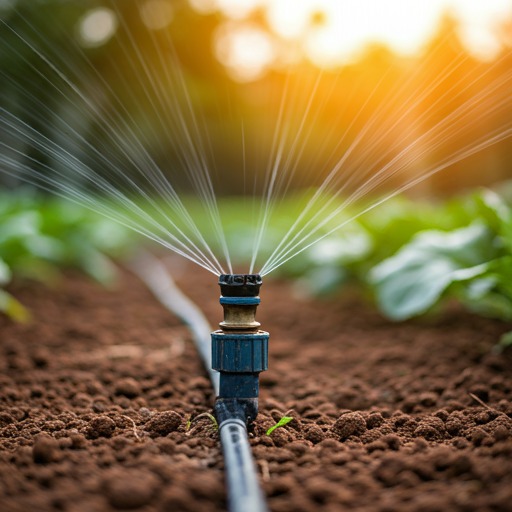In the world of modern agriculture, water efficiency is a crucial factor that influences both the sustainability and profitability of farmland investments. Drip irrigation has become a cornerstone of sustainable agriculture due to its precision, efficiency, and environmental benefits. For investors in Utopiaa’s managed farmland projects, understanding how water is conserved and productivity is maximised offers a direct insight into the value of their investment. Utopiaa’s projects employ advanced drip irrigation techniques, demonstrating how such practices contribute to land fertility, reduced operational costs, and increased returns.
Drip irrigation is a highly efficient, low-volume irrigation method that delivers precise amounts of water directly to a plant’s root zone. By releasing water in controlled drips, this system conserves water, reduces evaporation, and prevents nutrient leaching, unlike flood or sprinkler systems that can lead to soil erosion and nutrient depletion. Additionally, drip irrigation enables nutrients to be administered along with water, fostering targeted feeding and promoting plant health. Utopiaa’s implementation of this technique in its projects supports crop yield, maximises water efficiency, and aligns with sustainable agricultural principles.
In practical application, Utopiaa’s drip systems adjust flow rates and timings based on soil type, crop, and climate conditions, minimising excess water while ensuring steady growth. This system has been especially beneficial for water-intensive and high-value crops across Utopiaa’s managed farmland, enhancing productivity and soil integrity. Through such efficient water management, drip irrigation not only boosts land productivity but also supports Utopiaa’s broader eco-conscious mission, making it ideal for farmland investment and sustainable food production.

1. Optimised Water Usage Drip irrigation systems use up to 50% less water than traditional irrigation, making them ideal for conserving resources while ensuring plants are properly nourished. By carefully regulating the amount of water each crop receives, Utopiaa not only conserves water but also maximises the growth and health of crops on its managed farmland. This efficient use of water ensures that every inch of land is productive, contributing to the plot’s overall value and appeal to investors.
2. Enhanced Crop Yield and Quality By maintaining a consistent water supply directly at the root level, plants experience less water stress, which is critical for producing high-quality crops. Healthy, abundant crops are more resilient and command better market prices, directly translating to greater returns for investors. In Utopiaa’s agrotourism-centric projects, high-quality produce also adds value for tourists who participate in on-farm experiences such as harvesting and culinary workshops.
3. Lower Operational Costs Drip irrigation reduces water costs significantly and minimises the need for labour-intensive watering practices, ultimately cutting down operational expenses. Lower costs mean more efficient farm management and better profitability on each plot. For managed farmland investors at Utopiaa, reduced operational costs mean better margins on agricultural productivity, which contributes to long-term investment gains.
Utopiaa has seamlessly integrated drip irrigation systems across its varied projects in Karnataka, adapting the technology to meet the unique demands of each plot:
Through these carefully implemented systems, Utopiaa’s projects effectively utilize drip irrigation not only to conserve water but also to support a wide range of agricultural and tourism activities that enhance land value and promote sustainable land management.
Through these carefully implemented systems, Utopiaa’s projects effectively utilize drip irrigation not only to conserve water but also to support a wide range of agricultural and tourism activities that enhance land value and promote sustainable land management.
Our Ecopia project in Coorg stands as a model for sustainable, high-yield farming through drip irrigation. Set amidst Coorg’s naturally lush but sometimes inconsistent rainfall, Ecopia’s plantations of sandalwood and black pepper faced significant challenges in maintaining consistent growth and yield across seasons. Prior to installing a drip irrigation system, the plantation struggled with water dependency on rainfall patterns, which led to periods of both overwatering and drought stress.
Upon implementing an advanced, high-efficiency drip irrigation system, we transformed both water use and yield outcomes. The system provides slow, targeted hydration directly to the roots of each plant, minimising runoff and optimising absorption. This tailored approach to watering reduced Ecopia’s overall water usage by nearly 40%, cutting down on wastage and reducing environmental impact.
At the same time, the carefully controlled irrigation schedule provided plants with consistent hydration, protecting them from the fluctuations of natural rainfall. This has led to a 30% increase in yield for black pepper and sandalwood, two high-value crops sensitive to moisture levels. The stable growth cycle also improved the quality of the produce, resulting in a premium product that commands higher market prices.
Our journey with Ecopia illustrates how efficient water management not only conserves resources but also increases land productivity, which boosts the market value of the farm itself. Drip irrigation has proved essential for Ecopia’s success, showing potential investors how sustainable practices can lead to both ecological and economic gains.
By proactively addressing these challenges, Utopiaa maintains its commitment to eco-friendly, efficient water management, maximising productivity and land value for investors.
In addition to enhancing productivity, Utopiaa’s drip irrigation practices offer crucial environmental and social benefits that align with the company’s mission for sustainable agriculture and community involvement:

Utopiaa’s drip irrigation initiative thus exemplifies a holistic approach to agriculture that prioritises environmental stewardship, community engagement, and long-term sustainability. These benefits not only enhance the quality of the land but also build resilient local communities and ecosystems.
Drip irrigation marks a pivotal advancement in sustainable agriculture, transforming water management into a catalyst for productivity, profitability, and environmental stewardship. By committing to this water-efficient system across our managed farmland projects, we maximise both land value and ecological health, ensuring each plot is a model of resource-conscious farming. This dedication not only strengthens soil health and crop resilience but also delivers tangible, long-term benefits to investors. With an emphasis on efficient water use, Utopiaa’s approach showcases how innovative, sustainable practices can align profitability with environmental responsibility. For investors, it means a steady growth in farmland value and enhanced returns, underpinned by eco-friendly, forward-looking land management practices.
Interested in exploring how sustainable water management can elevate farmland investments? Discover our unique approach to eco-friendly farming by visiting utopiaa. With projects designed for productivity and environmental stewardship, Utopiaa invites you to invest in a greener future. Join us in redefining farmland investments through sustainable practices, where every drop counts.